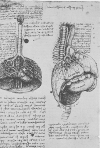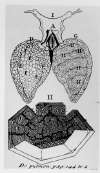A HISTORY OF THE LUNG![]() S
S
"The substance of the lung is dilatable and extensible like the tinder made from a fungus. But it is spongy and if you press it, it yields to the force which compresses it, and if the force is removed, it increases again to its original size." -- Leonardo da Vinci, late 15th century
Early descriptions of the lungs emphasized their importance as cooling agents that maintained the balance of the human body by counteracting the hot temperament of the heart. They also understood that breathing occurred in the lungs, in essence, that the lungs acted like a pair of bellows firing and cooling a furnace. Galen's description, for example, of the lung emphasized that it "has all the properties which make for easy evacuation; for it is very soft and warm and is kept in constant motion." He further specified the function of the lungs in relationship to the movement of the blood as follows: "Blood passing through the lungs absorbed from the inhaled air, the quality of heat, which it then carried into the left heart." From such passages, we can see that the idea of respiration was primarily influenced by humoral theories of the body.
Medieval medical practitioners continued to be fascinated by the unusual anatomy of the lung. They noted its unusual moisture, for example, as a feature of its complexion. In the early eleventh century, the Islamic medical philosopher Avicenna wrote in his Canon of Medicine: "In the case of the lung the moisture is not inherent in its nature but is derived from the nourishment which comes to it. The lung is fed by a very 'hot' blood, because there is much bilious humor in the blood going to the lung. A great excess of moisture accumulates in the lung from the gaseous products of the whole body as well as from the materials which flow down to it from the "head." By the late twelfth century, Master Nicolaus summarized well the qualities of the lung: it was built to "withstand the warmth of the heart," its soft, spongy tissue facilitated motion, it was hollow in order to retain air "for cooling the heart and renewing the vital spirits," and it exhibited a twofold motion that further facilitated its role as "the flail of the heart."
Medieval and Renaissance physicians understood the connection between the lungs and respiration and between life and breath. They associated life with a vitality that coursed throughout the body, a Galenic pneuma. But they had no specific understanding of the role that oxygen played, since they had no chemical understanding of air which was one of the four basic "elements" of nature in traditional Greek science. Despite this fact, they did understand that the lung discharged wastes. Leonardo da Vinci describes the process as follows in his unpublished notebooks of the late fifteenth century: "From the heart, impurities or 'sooty vapors' are carried back to the lung by way of the pulmonary artery, to be exhaled to the outer air." His contemporary, the physician Alessandro Benedetti concurred, writing in 1497, "The lung changes the breath, as the liver changes the chyle, into food for the vital spirit."
 Despite Leonardo's carefully drawn
images of the anatomy of the lungs, as seen in the illustration here, he did not
yet understand the relationship between form and function in any great
detail. What he, like many early anatomists, had grasped was the lung's
important role as an organ that worked cooperatively with closely allied organs
and structures in the human body. What he understood, as the passage below
suggests, is the mechanical process of breathing but not the actual mechanisms
at work in creating a breath. "The gust of wind driven out of the lung in the generation of a
large breath comes from the aid of the abdominal wall which compresses the
intestines, and they elevate the diaphragm which compresses the lungs."
Despite Leonardo's carefully drawn
images of the anatomy of the lungs, as seen in the illustration here, he did not
yet understand the relationship between form and function in any great
detail. What he, like many early anatomists, had grasped was the lung's
important role as an organ that worked cooperatively with closely allied organs
and structures in the human body. What he understood, as the passage below
suggests, is the mechanical process of breathing but not the actual mechanisms
at work in creating a breath. "The gust of wind driven out of the lung in the generation of a
large breath comes from the aid of the abdominal wall which compresses the
intestines, and they elevate the diaphragm which compresses the lungs."
Renaissance anatomists stuck closely to a complexion theory of the lungs that also gave them a role in the psychology of the human body. Leonardo's contemporary, the physician Alessandro Benedetti, wrote in 1497 that the lungs controlled emotions such as anger by placating the passions " with the breath of the spirit from the hollow fistulae of the lungs. Thus anger, otherwise implacable, is easily calmed." Similarly, some anatomists endowed the lungs with powers of discernment that prevented them from accepting "bad air" into the human body. Just as the lungs could make "food" for the body, they could also prevent poisonous thoughts and substances from overwhelming it.
The more careful anatomical studies of the human body conducted by Renaissance anatomists yielded a more precise physical description of the lungs. Whereas Master Nicolaus had described the human lung as having seven lobes, early sixteenth-century anatomists reduced that number to five. They noted that the sponginess of the lungs facilitated breathing, though the nature of breathing was still described much as Galen had done: "so that they may more easily draw the spirit into themselves," was how Andreas de Laguna put it in 1535. Yet only a few decades later, we can begin to see emerging doubts about the kind of spirit flowing through the lungs. "This air is not a pure element but an airy body and thus can nourish," wrote Vesalius' contemporary Niccolo Massa in 1559, "although Galen, that great philosopher, thought he understood it in another sense, for air prepared in the lung itself nourishes or restores the spirit."
Writing from an entirely different philosophical tradition, the German mystic and medical reformer Paracelsus made the study of lung diseases at the beginning of the sixteenth century a case study in understanding how disease might be localized to a specific organ rather than a general imbalance of the body. In his On the Miner's Sickness, he identified lung-related ailments, especially silicosis, as a direct product of working in the mines. Such research further emphasized the importance of the lungs to the overall health of the body.
By the early seventeenth century, the new anatomy
of the lung was in place. William Harvey concurred with his Renaissance
predecessors on the five-lobe structure of the lungs. Yet he took their views several
steps further in
describing the significance of the lungs. Having already established a new
physiology of the body in his On the Circulation of the Blood (1628),
Harvey had a different understanding of the relationship between arteries and
veins -- no longer separate circulatory systems within the body but a unified
system. As a result, he had a question: what makes arterial blood
different from venous blood? In his famous work, Harvey had described in
great detail pulmonary transit in the lungs. As a result, he had the
following to say about the lungs in his Lectures on the Whole of Anatomy
(1653):
with his Renaissance
predecessors on the five-lobe structure of the lungs. Yet he took their views several
steps further in
describing the significance of the lungs. Having already established a new
physiology of the body in his On the Circulation of the Blood (1628),
Harvey had a different understanding of the relationship between arteries and
veins -- no longer separate circulatory systems within the body but a unified
system. As a result, he had a question: what makes arterial blood
different from venous blood? In his famous work, Harvey had described in
great detail pulmonary transit in the lungs. As a result, he had the
following to say about the lungs in his Lectures on the Whole of Anatomy
(1653):
"Pre-eminence [of the lung]: nothing is especially so necessary neither sensation nor aliment. Life and respiration are complementary. There is nothing living which does not breathe nor anything which breathing which does not live."
This insight was followed by a strong critique of Galen, who had argued that the liver was the first and most important organ of the body. Harvey concluded the opposite: "The lungs make the spirits and indicate the nourishment wherefore more worthy than the liver if honor is judged by benefit." Instead he drew inspiration from Aristotle in arguing that spirit was not a product of air but of blood, and the lungs were therefore indicative of a person's temperament. Bold people have hot lungs, timid people have cold lungs. While creating a new physiology that gave greater importance to the lungs, Harvey was nonetheless deeply indebted to older traditions of thought. As a practicing physician, he also recognized that healthy lungs were essentially to the overall health of the body. In anticipation of more modern attitudes towards this organ, he wrote that exercise was important to the maintenance of this organ. He still, of course, had no idea about oxygen, nor even knew this word.
QUESTIONS: WHY MIGHT THE RELATIONSHIP BETWEEN THE HEART AND THE LUNGS HAVE BEEN AN OBSTACLE IN FULLY UNDERSTANDING THEIR FUNCTION? WHAT TEMPERAMENTAL PROPERTIES DID PHYSICIANS ASCRIBE TO THE LUNGS?